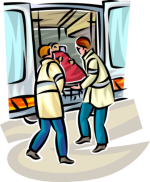Paramedics and dementia care
By AAG member:
Max Han, BParamed(Hons)
If I were to say to you now that the global cost of dementia care in 2019 was estimated to be $1.3 trillion US dollars,(1) your first thoughts would perhaps be surrounding cutting-edge diagnostics and pharmaceutical advances – which are, undoubtedly, some of the key cornerstones of dementia action plans. Not forgetting too, that post-diagnostic support, is something that Australia ‘urgently needs’.(2) Rather than offering the usual rhetoric of dementia policy and statistics, my aim in this blog is to offer the viewpoint that paramedics be part of post-diagnostic support for all individuals living with dementia.
Who are paramedics?
For those of you who missed the Paramedics TV series, paramedics are healthcare professionals (yes, we are registered with AHPRA), who play a crucial and fundamental role in health systems. We are equipped to deliver care across acute, specialist and primary settings, with recent forays into community care.(3) The emergent nature of our work puts us at the front line of clinical and psychosocial support for people in crisis – medical or not. Our skillsets are informed by various levels of clinical decision-making processes (4) that allow us to accurately take a history, assess symptoms such as your pain, and manage your condition accordingly in the out-of-hospital environment.
Where is the link between paramedics and dementia?
In the context of dementia, behavioural and psychological symptoms complicate assessments of pain and cognitive status. Compounded with communication difficulties, paramedics reportedly feel ill-equipped in delivering the best care, frequently resulting in a trip to the hospital out of exasperation.(5) This is ironic given the broad array of skills that paramedics are equipped with.
Where are the gaps?
A quick scan of the literature tells us a few things. First, that the accurate documentation of dementia by the paramedic is highly variable and dependent upon information at-scene. (6) Second, while almost 90% of ambulances attendances to persons aged 65 and over in residential aged care homes in Victoria resulted in a hospital conveyance, there was a disproportionately low incidence of any paramedic intervention.(7) And third, while paramedics were indeed aware that emergency departments (EDs) are far from the best environments for people living with dementia (ED -stimuli onslaught-life-threatening delirium), they were bound by a duty to alleviate carer frustration with navigating alternate care pathways.(8)
What is my vision for the future?
As a young and ambitious paramedic graduate caring for loved ones living with dementia, I constantly challenge myself to think of how I may create a quality improvement movement within my profession. Currently, paramedics barely receive any mention in dementia guidelines such as those of the prestigious National Health and Medical Research Council.(9) Perhaps this is because the role of the paramedic in the dementia care trajectory is still unclear. When there is no clarity, we cannot appropriately tackle the gaps.
Just as Scotland has pioneered Dementia Link Worders in its National Strategy,(10) and the UK has launched the first dementia-friendly ambulance,(11) my hope is for today’s health leadership to critically examine how the paramedic skillset may be adequately right-sized to dementia care so every individual living with dementia would not be short-changed during care transitions between the hospital and the community.
References:
1. World Health Organisation (WHO). Fact Sheets: Dementia [Internet]. Geneva: WHO; 2023.
2. Low L-F. Why Australia urgently needs post-diagnostic support and treatment for dementia. Australian Journal of Dementia Care. 2019;8(6).
3. Wilkinson-Stokes M. A taxonomy of Australian and New Zealand paramedic clinical roles. Australasian Journal of Paramedicine. 2021;18:1-20.
4. Jensen J. Paramedic clinical decision-making: results of two Canadian studies. International Paramedic Practice. 2011;1(2):63-71.
5. Voss S, Brandling J, Black S, Cheston R, Cullum S, Iliffe S, et al. Carer and clinician perceptions of the use of emergency medical services by people with dementia: a qualitative study. Primary Health Care Research & Development. 2019;20:e53.
6. Jadzinski P, Pocock H, Lofthouse-Jones C, King P, Taylor S, England E, et al. Improving recording and reporting of dementia and frailty via electronic patient record by ambulance staff in a single service (IDEAS). British Paramedic Journal. 2021;6(3):31-40.
7. Dwyer RA, Gabbe BJ, Tran T, Smith K, Lowthian JA. Residential aged care homes: Why do they call ‘000’? A study of the emergency prehospital care of older people living in residential aged care homes. Emergency Medicine Australasia. 2021;33(3):447-56.
8. Jacobsohn GC, Hollander M, Beck AP, Gilmore‐Bykovskyi A, Werner N, Shah MN. Factors influencing emergency care by persons with dementia: Stakeholder perceptions and unmet needs. Journal of the American Geriatrics Society. 2019;67(4):711-8.
9. Guideline Adaptation Committee (GAC). Clinical Practice Guidelines and Principles of Care for People with Dementia [Internet]. Sydney NSW: Guideline Adaptation Committee, Cognitive Decline Partnership Centre (CDPC); 2016.
10. Scottish Government. Scotland's National Dementia Strategy 2017-2020 [Internet]. Edinburgh GB-SCT: Scottish Government; 2017.
11. East Midlands Ambulance Service. First dementia friendly ambulance to launch in the UK. Nottingham (UK): East Midlands Ambulance Service NHS Trust; 2019.
For AAG members, this blog is also available as a pdf.